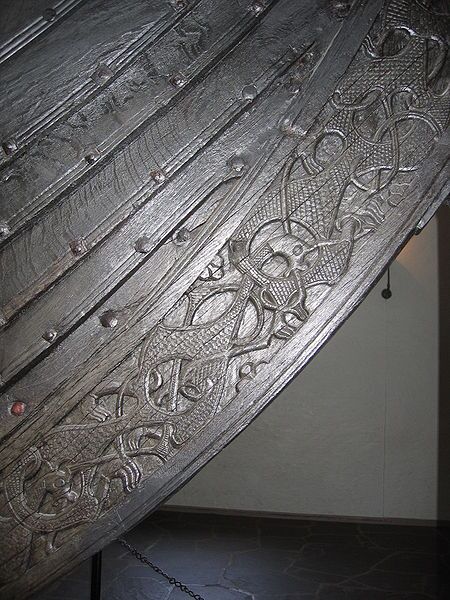Viking art is emblematic of the surprisingly ornate material culture of the Northerners. Vikings loved elaborate decorations and they decorated many of the things they used: weapons, jewelry, runestones, ship woodwork and even their common, everyday items. They loved abstract and intricate animal designs and multiple interlacing lines. The animals depicted in their art include serpents, horses, wolves, birds and unreal, fantastic animals. As the Viking Age progressed, craftsmen varied the designs and six distinct but overlapping art styles developed. Each style is named for an area where a decorated object was found. We’ll take a look at each of the art styles.
Oseberg
The Oseberg style lasted most of the 9th century and appears in some Viking religious iconography. Its main feature is the gripping beast motif and sinuous animal forms. Paws grip borders, the neck of the creature, other creatures or other parts of its body. The gripping beast must have echoed something in the culture of Viking art as it stood fast for a good 150 years.
Borre
The Borre style was named for a set of bridle mounts from a ship burial at Borre, Norway. The Borre overlaps with the Oseberg and the Jelling styles, periods specific to the Viking Age. While the gripping beast remains, the sinuous creature of the Oseberg style now boasts a triangular head, a cat-like face with round eyes and protruding ears. This style appears to be purely Norse with no outside influences. It has appeared in Iceland, Russia, England, which shows Viking art existed wherever they went. Borre was prominent from the end of the 9th century to the middle of the 10th.
Jelling
The Jelling style appears from the start of the 10th century and continues for about 75 years. Stylistic animals are S-shaped and intertwined, with profiled heads, spiral hips and pigtails. Borre and Jelling overlap and occasionally both are used on the same object.
Mammem
The Mammem Viking art style emerged from the Jelling style and was prominent in the last half of the 10th century. Almost naturalistic lions and birds are featured as well as serpents and foliate patterns. The name comes from a small ax head from a grave site in Mammem, Denmark. The ax head was carved, then inlayed with silver. On one side of the axe head is a foliate pattern and on the other is a stylized, ribbon-like bird with tendrils on wings and tail.
Ringerike
The first half of the 11th century featured the Ringerike style in Viking art. Lion-shaped beasts still appear as well as plant motifs and foliate patterns. Also during this time, runestones became more prominent and were decorated in the Ringerike fashion. Ringerike animals are exceedingly curvy and thin with almond-shaped eyes and thinner, longer tendrils.
Urnes
The Urnes style dates from 1050 to the 12th century and gets its name from a stave church in Urnes, Norway. Carved wooden panels reveal sinuous animals interlacing and looping, with long eyes pointed forward. Snakes and plants are also featured. The greyhound-like creature appears to be fighting with a serpent.
This article is part of our larger selection of posts about Vikings history. To learn more, click here for our comprehensive guide to Vikings history
Cite This Article
"Viking Art: The Six Art Styles" History on the Net© 2000-2024, Salem Media.
April 24, 2024 <https://www.historyonthenet.com/viking-art>
More Citation Information.

